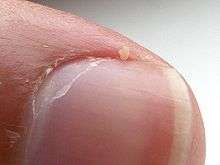Nail (anatomy)
A nail is a horn-like keratinous plate at the tip of the fingers and toes in most primates. Nails correspond to claws found in other animals. Fingernails and toenails are made of a tough protective protein called alpha-keratin which is found in the hooves, hair, claws and horns of vertebrates.[1]
| Nail | |
|---|---|
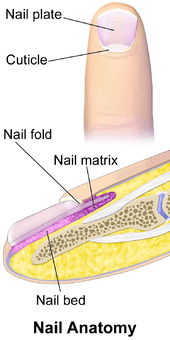 | |
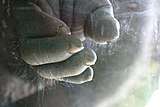 A gorilla's fingernails | |
| Details | |
| System | Integumentary system |
| Identifiers | |
| Latin | unguis |
| MeSH | D009262 |
| TA | A16.0.01.001 |
| TH | H3.12.00.3.02001 |
| FMA | 54326 |
| Anatomical terminology | |
Structure
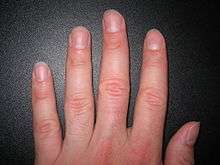
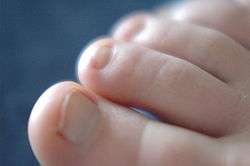
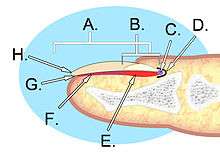
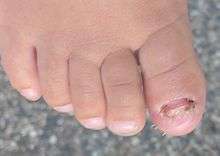
The nail consists of the nail plate, the nail matrix and the nail bed below it, and the grooves surrounding it.[2]
Parts of the nail
The matrix, sometimes called[3] the matrix unguis, keratogenous membrane, nail matrix, or onychostroma, is the tissue (or germinal matrix) which the nail protects.[4] It is the part of the nail bed that is beneath the nail and contains nerves, lymph and blood vessels.[5] The matrix produces cells that become the nail plate. The width and thickness of the nail plate is determined by the size, length, and thickness of the matrix, while the shape of the fingertip bone determines if the nail plate is flat, arched, or hooked.[6] The matrix will continue to produce cells as long as it receives nutrition and remains in a healthy condition.[7] As new nail plate cells are made, they push older nail plate cells forward; and in this way older cells become compressed, flat, and translucent. This makes the capillaries in the nail bed below visible, resulting in a pink color.[8]
The lunula ("small moon") is the visible part of the matrix, the whitish crescent-shaped base of the visible nail.[9] The lunula can best be seen in the thumb and may not be visible in the little finger.
The nail bed is the skin beneath the nail plate.[9] Like all skin, it is made of two types of tissues: the deeper dermis, the living tissue which includes capillaries and glands,[10] and the epidermis, the layer just beneath the nail plate, which moves toward the finger tip with the plate. The epidermis is attached to the dermis by tiny longitudinal "grooves"[6] called matrix crests (cristae matricis unguis).[4][10] In old age, the nail plate becomes thinner, and these grooves become more visible.[6]
The nail sinus (sinus unguis) is where the nail root is;[4] i.e. the base of the nail underneath the skin. It originates from the actively growing tissue below, the matrix.[5]
The nail plate (corpus unguis)[4] is the hard part of the nail, made of translucent keratin protein. Several layers of dead, compacted cells cause the nail to be strong but flexible.[6] Its (transverse) shape is determined by the form of the underlying bone.[6] In common usage, the word nail often refers to this part only.
The free margin (margo liber) or distal edge is the anterior margin of the nail plate corresponding to the abrasive or cutting edge of the nail.[4] The hyponychium (informally known as the "quick")[11] is the epithelium located beneath the nail plate at the junction between the free edge and the skin of the fingertip. It forms a seal that protects the nail bed.[5] The onychodermal band is the seal between the nail plate and the hyponychium. It is just under the free edge, in that portion of the nail where the nail bed ends and can be recognized in fair-skinned people by its glassy, greyish colour. It is not visible in some individuals while it is highly prominent on others.[6]
Eponychium
Together, the eponychium and the cuticle form a protective seal. The cuticle is the semi-circular layer of almost invisible dead skin cells that "ride out on" and cover the back of the visible nail plate while the eponychium is the fold of skin cells that produces the cuticle. They are continuous, and some references view them as one entity; in this classification, the names eponychium, cuticle, and perionychium are synonymous.[12] It is the cuticle (nonliving part) that is removed during a manicure, but the eponychium (living part) should not be touched due to risk of infection.[8] The eponychium is a small band of living cells (epithelium) that extends from the posterior nail wall onto the base of the nail.[4] The eponychium is the end of the proximal fold that folds back upon itself to shed an epidermal layer of skin onto the newly formed nail plate. The perionyx is the projecting edge of the eponychium covering the proximal strip of the lunula.[4]
The nail wall (vallum unguis) is the cutaneous fold overlapping the sides and proximal end of the nail. The lateral margin (margo lateralis) lies beneath the nail wall on the sides of the nail, and the nail groove or fold (sulcus matricis unguis) are the cutaneous slits into which the lateral margins are embedded.[4]
Paronychium
The paronychium is the soft tissue border around the nail,[13] and paronychia is an infection in this area.
Hyponychium
The hyponychium is the area of epithelium, particularly the thickened portion, underlying the free edge of the nail plate. It is sometimes called the quick as in the phrase 'cutting to the quick'.
Function
A healthy fingernail has the function of protecting the distal phalanx, the fingertip, and the surrounding soft tissues from injuries. It also serves to enhance precise delicate movements of the distal digits through counter-pressure exerted on the pulp of the finger.[2] The nail then acts as a counter-force when the end of the finger touches an object, thereby enhancing the sensitivity of the fingertip,[14] although the nail itself has no nerve endings. Finally, the nail functions as a tool enabling a so-called "extended precision grip" (e.g. pulling out a splinter in one's finger), and certain cutting or scraping actions.
Growth
The growing part of the nail is under the skin at the nail's proximal end under the epidermis, which is the only living part of a nail.
In mammals, the growth rate of nails is related to the length of the terminal phalanges (outermost finger bones). Thus, in humans, the nail of the index finger grows faster than that of the little finger; and fingernails grow up to four times faster than toenails.[15]
In humans, fingernails grow at an average rate of approx. 3.5 mm (0.14 in) a month, whereas toenails grow about half as quickly (approx. average 1.6 mm (0.063 in) a month).[16] Fingernails require three to six months to regrow completely, and toenails require twelve to eighteen months. Actual growth rate is dependent upon age, sex, season, exercise level, diet, and hereditary factors.[17] The longest female nails known ever to have existed measured a total of 601.9 cm, an average of 60.19 cm (23.7 inches) for each fingernail.[18] Contrary to popular belief, nails do not continue to grow after death; the skin dehydrates and tightens, making the nails (and hair) appear to grow.[19]
Permeability
The nail is often considered an impermeable barrier, but this is not true. In fact, it is much more permeable than the skin,[20] and the composition of the nail includes 7–12% water. This permeability has implications for penetration by harmful and medicinal substances; in particular cosmetics applied to the nails can pose a risk. Water can penetrate the nail as can many other substances including paraquat, a fast acting herbicide that is harmful to humans, urea which is often an ingredient in creams and lotions meant for use on hands and fingers, and several fungicidal agents such as salicylic acid, miconazole branded Monistat, natamycin; and sodium hypochlorite which is the active ingredient in common household bleach (but usually only in 2–3% concentration).[20]
Clinical significance
Healthcare and pre-hospital-care providers (EMTs or paramedics) often use the fingernail beds as a cursory indicator of distal tissue perfusion of individuals who may be dehydrated or in shock.[21] However, this test is not considered reliable in adults.[22] This is known as the CRT or blanch test. The fingernail bed is briefly depressed to turn the nail-bed white. When the pressure is released, the normal pink colour should be restored within a second or two. Delayed return to pink color can be an indicator of certain shock states such as hypovolemia.[23][24]
Nail growth record can show the history of recent health and physiological imbalances, and has been used as a diagnostic tool since ancient times.[25] Deep, horizontally transverse grooves known as "Beau's lines" may form across the nails (horizontal, not along the nail from cuticle to tip). These lines are usually a natural consequence of aging, although they may result from disease. Discoloration, thinning, thickening, brittleness, splitting, grooves, Mees' lines, small white spots, receded lunula, clubbing (convex), flatness, and spooning (concave) can indicate illness in other areas of the body, nutrient deficiencies, drug reaction or poisoning, or merely local injury.
Nails can also become thickened (onychogryphosis), loosened (onycholysis), infected with fungus (onychomycosis), or degenerate (onychodystrophy). A common nail disorder is an ingrowing toenail (onychocryptosis).
DNA profiling is a technique employed by forensic scientists on hair, fingernails, toenails, etc.
Health and care
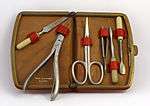
The best way to care for nails is to trim them regularly. Filing is also recommended, as to keep nails from becoming too rough and to remove any small bumps or ridges that may cause the nail to get tangled up in materials such as cloth.[26]
Bluish or purple fingernail beds may be a symptom of peripheral cyanosis, which indicates oxygen deprivation.
Nails can dry out, just like skin. They can also peel, break, and be infected. Toe infections, for instance, can be caused or exacerbated by dirty socks, specific types of aggressive exercise (long-distance running), tight footwear, and walking unprotected in an unclean environment. Common organisms causing nail infections include yeasts and molds (particularly dermatophytes).[27]
Nail tools used by different people may transmit infections. Standard hygiene and sanitation procedures avoid transmission. In some cases, gel and cream cuticle removers can be used instead of cuticle scissors.
Nail disease can be very subtle and should be evaluated by a dermatologist with a focus in this particular area of medicine. However, most times it is a nail technician who will note a subtle change in nail disease.
Inherited accessory nail of the fifth toe occurs where the toenail of the smallest toe is separated, forming a smaller "sixth toenail" in the outer corner of the nail.[28] Like any other nail, it can be cut using a nail clipper.
Effect of nutrition
Vitamin A is an essential micro-nutrient for vision, reproduction, cell and tissue differentiation, and immune function. Vitamin D and calcium work together in cases of maintaining homeostasis, creating muscle contraction, transmission of nerve pulses, blood clotting, and membrane structure. A lack of vitamin A, vitamin D, or calcium can cause dryness and brittleness.
Insufficient vitamin B12 can lead to excessive dryness, darkened nails, and rounded or curved nail ends. Insufficient intake of both vitamin A and B results in fragile nails with horizontal and vertical ridges. Some over-the-counter vitamin supplements such as certain multivitamins and biotin may help in growth of strong nails, although this is quite subjective.[29]
Protein is a building material for new nails; therefore, low dietary protein intake may cause anemia and the resultant reduced hemoglobin in the blood filling the capillaries of the nail bed reflects varying amounts of light incident on the nail matrix resulting in lighter shades of pink ultimately resulting in white nail beds when the hemoglobin is very low. When hemoglobin is close to 15 or 16 grams, most of the spectrum of light is absorbed and only the pink color is reflected back and the nails look pink.
Essential fatty acids play a large role in healthy skin as well as nails. Splitting and flaking of nails may be due to a lack of linoleic acid.
Iron-deficiency anemia can lead to a pale color along with a thin, brittle, ridged texture. Iron deficiency in general may cause the nails to become flat or concave, rather than convex.[30]
Society and culture
Fashion
Manicures (for the hands) and pedicures (for the feet) are health and cosmetic procedures to groom, trim, and paint the nails and manage calluses. They require various tools such as cuticle scissors, nail scissors, nail clippers, and nail files. Artificial nails can also be fixed onto real nails for cosmetic purposes.
A person whose occupation is to cut, shape and care for nails as well as to apply overlays such as acrylic and UV gel is sometimes called a nail technician. The place where a nail technician works may be a nail salon or nail shop or nail bar.
.jpg)
Painting the nails with colored nail polish (also called nail lacquer and nail varnish) to improve the appearance is a common practice dating back to at least 3000 B.C. With the rise of smartphones, some analysts have noted a trend of the nelfie (nail selfie), wherein people share their nail art online.[31]
Length records
Guinness World Records began tracking record fingernail lengths in 1955, when a Chinese priest was listed as having fingernails 1 foot 10.75 inches (57.79 cm) long.
The current record-holder for men, according to Guinness, is Shridhar Chillal from India who set the record in 1998 with a total of 20 feet 2.25 inches (615.32 cm) of nails on his left hand. His longest nail, on his thumb, was 4 feet 9.6 inches (146.3 cm) long.
The record-holder for women is Lee Redmond of the U.S., who set the record in 2001 and as of 2008 had nails with a total length on both hands of 28 feet (850 cm), with the longest nail on her right thumb at 2 feet 11 inches (89 cm).[32]
Evolution in primates
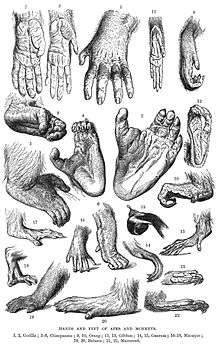
The nail is an unguis, meaning a keratin structure at the end of a digit. Other examples of ungues include the claw, hoof and talon. The nails of primates and the hooves of running mammals evolved from the claws of earlier animals.[33]
In contrast to nails, claws are typically curved ventrally (downwards in animals) and compressed sideways. They serve a multitude of functions—including climbing, digging, and fighting—and have undergone numerous adaptive changes in different animal taxa. Claws are pointed at their ends and are composed of two layers: a thick, deep layer and a superficial, hardened layer which serves a protective function. The underlying bone is a virtual mold of the overlying horny structure and therefore has the same shape as the claw or nail. Compared to claws, nails are flat, less curved, and do not extend far beyond the tip of the digits. The ends of the nails usually consist only of the "superficial", hardened layer and are not pointed like claws.[33]
With only a few exceptions, primates retain plesiomorphic (original, "primitive") hands with five digits, each equipped with either a nail or a claw. For example, nearly all living strepsirrhine primates have nails on all digits except the second toe which is equipped with a grooming claw. Tarsiers have a grooming claw on second and third toes. Less commonly known, a grooming claw is also found on the second pedal digit of owl monkeys (Aotus), titis (Callicebus), and possibly other New World monkeys.[34] The needle-clawed bushbaby (Euoticus) has keeled nails (the thumb and the first and the second toes have claws) featuring a central ridge that ends in a needle-like tip. In tree shrews, all digits have claws and, unlike most primates, the digits of their feet are positioned close together, and therefore, the thumb cannot be brought into opposition (another usually distinguishing feature of primates).[33]
A study of the fingertip morphology of four small-bodied New World monkey species indicated a correlation between increasing small-branch foraging and:
- expanded apical pads (fingertips),
- developed epidermal ridges (fingerprints),
- broadened distal parts of distal phalanges (fingertip bones), and
- reduced flexor and extensor tubercles (attachments areas for finger muscles on bones).
This suggests that whereas claws are useful on large-diameter branches, wide fingertips with nails and epidermal ridges were required for habitual locomotion on small-diameter branches. It also indicates keel-shaped nails of Callitrichines (a family of New World monkeys) is a derived postural adaptation rather than retained ancestral condition.[35]
See also
- List of cutaneous conditions
- Nail disease
- Nail fetish
- Onychogryphosis, overgrown, claw-like nails
References
- Wang, Bin (2016). "Keratin: Structure, mechanical properties, occurrence in biological organisms, and efforts at bioinspiration" (PDF). Progress in Materials Science. 76: 229–318. doi:10.1016/j.pmatsci.2015.06.001.
- Onumah, Neh; Scher, Richard K (May 2009). "Nail Surgery". eMedicine. Retrieved 10 March 2010.
- "Nail matrix". Biology Online. 2005. Retrieved 10 March 2010.
- Feneis, Heinz (2000). Pocket Atlas of Human Anatomy (4th ed.). Thieme. pp. 392–95. ISBN 3-13-511204-7.
- "Glossary of Nail Technology Terminology". 2008. Retrieved 10 March 2010.
- "Understanding Your Natural Nails". 2000. Retrieved March 10, 2010.
- D. Schoon, Dougles (2005). Nail Structure and Products Chemistry. Milady. p. 6.
- Lellipop (August 2006). "Anatomy of the nail". Salon Geek. Retrieved 10 March 2010.
- "Nail Anatomy". Nail Doctors. 2005. Retrieved March 10, 2010.
- "Glossary of Nail Conditions". The Achilles Foot Health Centre.
- Crouch, James Ensign (1985). Functional human anatomy. Lea & Febiger. p. 80. ISBN 9780812109306.
- Elsevier, Dorland's Illustrated Medical Dictionary, Elsevier.
- Jordan, Christopher; Mirzabeigi, Edwin (2000-04-01). Atlas of orthopaedic surgical exposures. Thieme. p. 101. ISBN 0-86577-776-4.
- Wang, Quincy C; Johnson, Brett A (May 2001). "Fingertip Injuries". American Family Physician. Retrieved 10 March 2010.
- Cartmill, Matt; Lemelin, Pierre; Schmitt, Daniel (2007). "Primate Gaits and Primate Origins". In Ravosa, Matthew J.; Dagosto, Marian (eds.). Primate Origins: Adaptations and Evolution. pp. 403–35. doi:10.1007/978-0-387-33507-0_12. ISBN 978-0-387-30335-2.
- Yaemsiri, S.; Hou, N.; Slining, M. M.; He, K. (2010). "Growth rate of human fingernails and toenails in healthy American young adults". Journal of the European Academy of Dermatology and Venereology. 24 (4): 420–423. doi:10.1111/j.1468-3083.2009.03426.x. ISSN 1468-3083. PMID 19744178.
- Hunter, J. A. A., Savin, J., & Dahl, M. V. (2002). Clinical dermatology. Malden, Mass: Blackwell Science. p. 173. ISBN 0-632-05916-8
- Glenday, Craig (2013). Guinness World Records 2014. The Jim Pattison Group. pp. 051. ISBN 978-1-908843-15-9.
- Vreeman, R. C; Carroll, A. E (2007). "Medical myths". BMJ. 335 (7633): 1288–9. doi:10.1136/bmj.39420.420370.25. PMC 2151163. PMID 18156231.
- K. A. Walters and G. L. Flynn, Permeability characteristics of the human nail plate, International Journal of Cosmetic Science 5, 231–46 (1983)
- Monterey County EMS Manual Archived 2008-12-16 at the Wayback Machine. Chapter XI, Patient assessment.
- Schriger DL, Baraff LJ (Jun 1991). "Capillary refill – is it a useful predictor of hypovolemic states?". Ann Emerg Med. 20 (6): 601–15. doi:10.1016/S0196-0644(05)82375-3. PMID 2039096.
- MedlinePlus Encyclopedia: Capillary nail refill test
- St. Luke's Hospital. Capillary nail refill test.
- American Academy of Dermatology – Nail Health
- Cohen, Philip R.; Scher, Richard K. (1992-04-01). "Geriatric nail disorders: Diagnosis and treatment". Journal of the American Academy of Dermatology. 26 (4): 521–531. doi:10.1016/0190-9622(92)70075-Q. ISSN 0190-9622. PMID 1597537.
- Denning, DW; Evans, EG; Kibbler, CC; Richardson, MD; Roberts, MM; Rogers, TR; Warnock, DW; Warren, RE (November 11, 1995). "Fungal nail disease: a guide to good practice (report of a Working Group of the British Society for Medical Mycology)". British Medical Journal. 311 (7015): 1277–81. doi:10.1136/bmj.311.7015.1277. PMC 2551187. PMID 7496239.
- Haneke E (May 2016). "Double Nail of the Little Toe". Skin Appendage Disorders. 1 (4): 163–7. doi:10.1159/000443378. PMC 4908446. PMID 27386457.
- Zempleni, J; R.B. Rucker; D.B. McCormick; J.W. Suttie (2007). Handbook of vitamins (4th ed.).
- Cashman MW, Sloan SB (2010). "Nutrition and nail disease". Clinics in Dermatology. 28 (4): 420–25. doi:10.1016/j.clindermatol.2010.03.037. PMID 20620759.
- Laneri, Raquel (18 April 2017). "Muslim women are showing off their insane nail art in 'nelfies'". NY Post. Retrieved 21 February 2019.
- "Crash breaks woman's record-length fingernails". NBCNews. December 2009.
- Ankel-Simons, Friderun (2007). Primate anatomy: an introduction (3rd ed.). pp. 342–44. ISBN 978-0-12-372576-9.
- Maiolino, S.; Boyer, D. M.; Rosenberger, A. (2011). "Morphological Correlates of the Grooming Claw in Distal Phalanges of Platyrrhines and Other Primates: A Preliminary Study". The Anatomical Record. 294 (12): 1975–90. doi:10.1002/ar.21498. PMID 22042603.
- Hamrick, Mark W. (1998). "Functional and adaptive significance of primate pads and claws: Evidence from New World anthropoids". American Journal of Physical Anthropology. Wiley-Liss. 106 (2): 113–27. doi:10.1002/(SICI)1096-8644(199806)106:2<113::AID-AJPA2>3.0.CO;2-R. PMID 9637179.
External links

